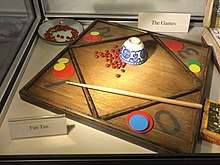Fan-Tan
Fan-Tan, or fantan (simplified Chinese: 番摊; traditional Chinese: 番攤; pinyin: fāntān, literally "repeated divisions") is a form of a gambling game long played in China. It is a game of pure chance which has similarities to roulette.


The game is played by placing two handfuls of beans or other objects on a board, and - after players have cast bets on values of 1 through 4 - repeatedly removing four beans from the board until only one, two, three or four beans remain, determining the winner.
History

The game may have arisen during third and fourth centuries, during the period of the Northern and Southern dynasties.[1] It then spread through southern China during the Qing dynasty.[2] The name fantan dates back only to the mid-nineteenth century. Before that time, fantan was known as yanqian 掩錢 (literally meaning “covering coins”, tanxi 攤 戲, tanqian 攤錢, yiqian 意錢.[3] It was prominent during the Late Qing and Republican period in Canton and the Pearl River Delta region.[2]
After 1850, fantan spread overseas as a side effect of the massive Cantonese emigration. As a rule, in places where a significant number of Cantonese migrants could be found, fantan was also present.[4] Fan-tan was very popular among Chinese migrants in America, as most of them were of Cantonese origin.[2][5] Jacob Riis, in his famous book about the underbelly of New York, How the Other Half Lives (1890), wrote of entering a Chinatown fan-tan parlor: "At the first foot-fall of leather soles on the steps the hum of talk ceases, and the group of celestials, crouching over their game of fan tan, stop playing and watch the comer with ugly looks. Fan tan is their ruling passion." The large Chinatown in San Francisco was also home to dozens of fan-tan houses in the 19th century. The city's former police commissioner Jesse B. Cook wrote that in 1889 Chinatown had 50 fan-tan games, and that "in the 50 fan tan gambling houses the tables numbered from one to 24, according to the size of the room."
Fan-tan is no longer as popular as it once was, having been replaced by modern casino games like Baccarat, and other traditional Chinese games such as Mah Jong and Pai Gow. Fan-tan is still played at some Macau casinos.[6]
The game
A square is marked in the center of an ordinary table, or a square piece of metal is laid on it, the sides being marked 1, 2, 3 and 4. The banker puts on the table a double handful of small buttons, beads, coins, dried beans, or similar articles, which he covers with a metal bowl. When all bets are placed, the bowl is removed and the "tan kun", or croupier, uses a small bamboo stick to remove the buttons from the heap, four at a time, until the final batch is reached. If it contains four buttons, the backer of No. 4 wins; if three, the backer of No. 3 wins; if two, the backer of No. 2 wins and if one the backer of No. 1 wins.[7]
All winning wagers are paid true odds less a house commission,[5] which ranges from 5% to 25%[7] depending on the time and place.[6][8] Nowadays, in Macau casinos, the house commission is uniformly set at 5%. For example, assume a bettor has $100 wagered on a 3 to 1 wager; if the bet wins, the bettor is paid $285 ($300 less 5%).
References
- Guo Shuanglin; Xiao Meihua (1996). Zhongguo dubu shi [History of gaming in China]. Taibei: Wenjin chubanshe. p. 225.
- Paulès, Xavier (26–28 September 2007). "" Le fantan, une étude préliminaire "" [The fantan, a preliminary study] (PDF). Atelier 37 : Le Jeu en Asie / Workshop 37 : Gambling in Asia, 3ème Congrès du Réseau Asie - IMASIE / 3rd Congress of Réseau Asie - IMASIE (in French). Paris, France. Archived from the original (PDF) on 15 July 2011.
- Xavier Paulès, « Gambling in China reconsidered: fantan in South China during the early twentieth century », International Journal of Asian Studies, vol. 7, n° 2 (July 2010), p. 179-200.
- Xavier Paulès, “An illustration of China’s “paradoxical soft power”: the dissemination of the gambling game fantan 番攤 by the Cantonese diaspora, 1850–1950”, Translocal Chinese: East Asian perspectives, vol. 11, no. 2 (Fall 2017), p. 187-207.
- Culin, Stewart (1891), "The Gambling Games Of The Chinese In America", Series in Philology Literature and Archaeology, Philadelphia, Pennsylvania, USA: University of Pennsylvania Press, I (4), retrieved August 30, 2017
- K., James (1 April 2009). "Fan Tan in Macau". The Wizard of Macau. Retrieved 30 August 2017.
- Chisholm, Hugh, ed. (1911). . Encyclopædia Britannica. 10 (11th ed.). Cambridge University Press. p. 171.
- Heller, Edmund (1917), Handwritten China journal, 5,
...less 10% for the house.